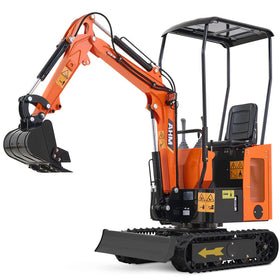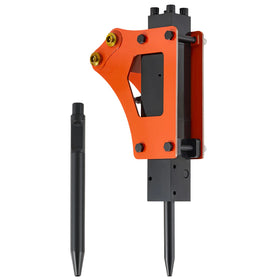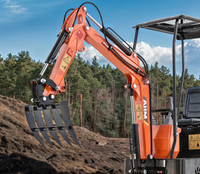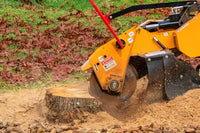Every time you need to switch attachments on your mini excavator, you face a choice. Get down from the cab, deal with the pins, climb back up. Do this a few times a day, and those minutes add up. That's why quick hitches make sense - they're a real time-saver on the job site.
But here's the thing: you've probably heard a lot about hydraulic quick hitches. They sound impressive in ads. Yet many operators find that manual quick hitches do exactly what they need at a fraction of the cost.

1. Quick Hitch Basics: Manual vs Hydraulic
Understanding the key differences between manual and hydraulic systems helps guide your decision:
|
Feature |
Manual Quick Hitch |
Hydraulic Quick Hitch |
|
Operation |
Direct mechanical connection |
Hydraulic-powered system |
|
Change Time |
3-5 minutes |
30 seconds - 1 minute |
|
Initial Cost |
$200-500 |
$1,000-2,000 |
|
Maintenance |
Basic cleaning and lubrication |
Regular hydraulic system checks |
|
Best For |
1-5 daily changes |
10+ daily changes |
2. Real Performance in Daily Operations
Let's talk about what actually happens on the job. With a manual quick hitch, you can change mini excavator attachments in about 3-5 minutes. That's a big improvement from the 15-20 minutes you spend with regular pins. For most daily jobs, this time saving is plenty.
The beauty of manual quick hitches is their simplicity. You can see right away if the attachment is locked. No hydraulic pressure to check. No complex parts to maintain. Just a solid connection you can trust, whether you're digging, grading, or moving materials. (If you're new to quick hitches, check out our guide on "How to use a quick hitch on your mini excavator" to get started.)
3. Understanding Daily Operational Needs
Think about your typical day. Maybe you switch from a bucket to an auger, then back again. Or you might need to change between different bucket sizes. A manual quick hitch makes these changes simple and fast. You get the speed you need without paying for features you won't use. Manual quick hitches prove most effective when:
- Attachment changes occur 1-5 times per day
- Multiple operators use the mini excavator
- Operations require reliable, consistent performance
- Cost-effectiveness is a priority
For most construction, landscaping, and general excavation work, manual quick hitches provide the optimal balance of efficiency and practicality.
4. The Economic Advantage
When evaluating quick hitch options, consider both immediate and long-term costs:
Initial Investment:
- Manual quick hitches typically range from $200-500
- Hydraulic systems can cost 3-4 times more
With a manual system, you won't need to buy hydraulic fluid or replace seals. No special maintenance tools required. Just basic care keeps it working well.
5. Safety and Reliability
Modern manual quick hitches incorporate several important safety features:
- Mechanical locking mechanisms prevent accidental release
- Visual indicators confirm proper attachment
- No risk of hydraulic system failures
- Simple safety checks before operation
Safety comes from simplicity. With a manual quick hitch, you can see if it's locked properly. The mechanical locks are straightforward - they either work or they don't. No wondering about hydraulic pressure or system failures. A quick visual check tells you everything is secure.
6. Compatibility Considerations

Fitting a quick hitch to your excavator is straightforward. You just need to know two things: your pin diameter and the distance between pins. Most mini excavator attachments use standard sizes, so matching them up is simple. No need to worry about hydraulic line compatibility or pressure ratings.
|
What to Check |
Where to Find It |
|
Pin Diameter |
Measure your current pins |
|
Pin Distance |
Measure center to center |
|
Weight Limit |
Check your excavator's specs |
7. Maintenance Requirements
Think about how you use your excavator. If you're switching mini excavator attachments a few times a day, a manual quick hitch hits the sweet spot. You get faster changes than pin-on attachments without the cost and complexity of hydraulics. Most operators find this is all they need.
8. Making an Informed Decision
Consider these key factors when evaluating quick hitch options:
- Daily attachment change frequency
- Type of work performed
- Operating environment
- Budget constraints
- Maintenance capabilities
For most mini excavators, manual quick hitches provide the ideal combination of efficiency, reliability, and cost-effectiveness.

Common Questions About Manual Quick Hitches
Q: What determines if a manual quick hitch is suitable for my operation?
A: Consider your daily attachment change frequency, budget, and maintenance capabilities. Manual systems typically work best for operations with 1-5 daily changes.
Q: How does maintenance compare between manual and hydraulic systems?
A: Manual quick hitches require basic cleaning and occasional lubrication, while hydraulic systems need regular fluid checks, seal maintenance, and line inspections.
Q: What's the typical return on investment period?
A: Manual quick hitches often pay for themselves through time savings within the first few months of regular use, especially when compared to traditional pin-on systems.
Q: How do weather conditions affect manual quick hitch performance?
A: Manual systems maintain consistent performance across various weather conditions, without the risk of hydraulic fluid temperature concerns.
The decision between manual and hydraulic quick hitches ultimately depends on your specific operational needs. For most excavation work, manual systems offer the optimal balance of efficiency, reliability, and value, making them the smart choice for practical, cost-conscious operations.







